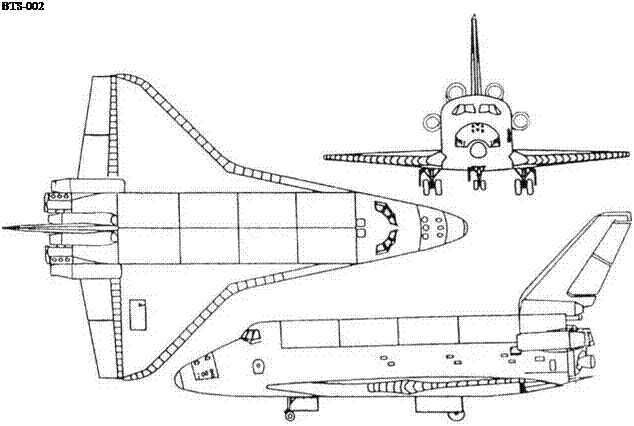Molniya Buran BTS-002
 |
Purpose: To develop the optimum Buran landing profiles and techniques and train Cosmonauts to fly the Buran spacecraft. Design Bureau: NPO Molniya, Moscow, GeneralDirectorGlebELozino-Lozinskii.
In 1976 the various A I Mikoyan spacecraft – Spiral and Epos, and the 105-11 described previously-were terminated and replaced by the Buran (Snowstorm) programme. This was assigned to NPO Energiya for the rocket launch vehicle, with a total thrust at boost separation of4,037 tonnes (8,900,000 Ib), and NPO Molniya for the reusable winged orbiter. Lozino-Lozinskii, then 67, was transferred from the MiG OKB to head the Molniya team. In 1978 work began on a series of BTS (initials from Russian for Big Transport Ship) projects which eventually totalled eight, BTS-001 through BTS-006 plus BTS-011 and BTS-015. Of these BTS-002 was a complete manned air vehicle to explore the landing profiles and handling, and – together with prolonged training on various other aircraft, notably a Tu-154LL – train the future crews. More than 7,000 atmospheric entries, glides and land
ings had been simulated mathematically, and in tunnel testing of models, but there was no substitute for actually flying a Buran type vehicle. In summer 1984 BTS-002 was taken by VM-T carrier aircraft to Jubilee airfield near the Cosmodrome at Baikonur. Here it began taxi testing on 29th December 1984.
Almost a year then elapsed before the first flight, on 10th November 1985 This was a single take-off, wide circuit and landing, lasting 12 minutes. The Commander was Igor P Volk and the pilot Rimantas A A Stankyavichus. This crew flew many other missions, together with five other Cosmonauts. An important flight was No 8, on 23rd December 1986, when the Volk/Stankyavichus crew made the first ‘hands off automatic approach and landing from a height of 4km.
The last flight of BTS-002 took place on 15th April 1988, just over seven months before the first launch of a Buran in November 1988 made the ‘atmospheric analog’ redundant. It made a final high-speed taxi test on 20th December 1989 and was then retired, but placed on view to the public at MosAero-92 at Zhukovskii.
The airframe ofBTS-002 was geometrically identical to the Buran, and it had the same flight-control system and software. The four large elevens, four sections of rudder (upper and lower left and upper and lower right, which split apart to act as airbrakes) and door-type ventral airbrake were identical. So were the twin-wheel landing gears, K-36L seats and triple cruciform braking parachutes. On the other hand it was devoid of the 38,000 ceramic tiles and of virtually all the complex on-board systems of the spacecraft.
|
Dimensions |
||
|
Span |
23.92 m |
78 ft 53/4 in |
|
Length |
36.367 m |
119 ft 33/ in |
|
Wing area |
250 nf |
2,690ft2 |
|
Weights |
||
|
Empty, similar to Buran |
82 tonnes |
180,77615 |
|
Loaded, less than the orbiter 96 tonnes |
211,640Ib |
|
|
Performance |
||
|
Normal maximum speed |
||
|
on each flight |
600 km/h |
373 mph |
|
Normal peak of trajectory |
4,000 m |
13,123ft |
|
Endurance |
SOmin |
 |
In particular, the propulsion systems were totally different. The orbiter had no main engines, relying totally on the mighty launch rocket, but it did have two OMEs (orbital manoeuvring engines) and 42 small thrusters for attitude control in space. The BTS-002 needed none of these, but instead had four Lyul’- ka AL-21F-3 afterburning turbojets, each rated at 11,200kg (24,800 Ib) thrust. These were arranged one on each side of the rear fuselage and one on each side at the base of
the fin. Of course it also needed a conventional kerosene fuel system. The engines were used only for taxying to the runway and for take-off and landing. The important part of the flight had to be a glide, simulating the or- biter. Presence of the four air-breathing engines was said to have little effect upon the vehicle’s flight characteristics.
BTS-002 did everything it was designed to do. Unfortunately, the main Buran programme eventually ran eight years later and
overran its budget severely. Nevertheless, in the opinion of Vyacheslav Filin, Deputy General Constructor at NPO Energiya, ‘Had it not been for existence of the Buran system there would have been no Reykjavik meeting where Reagan suggested sharing Star Wars technology and which led to strategic arms reduction’.










